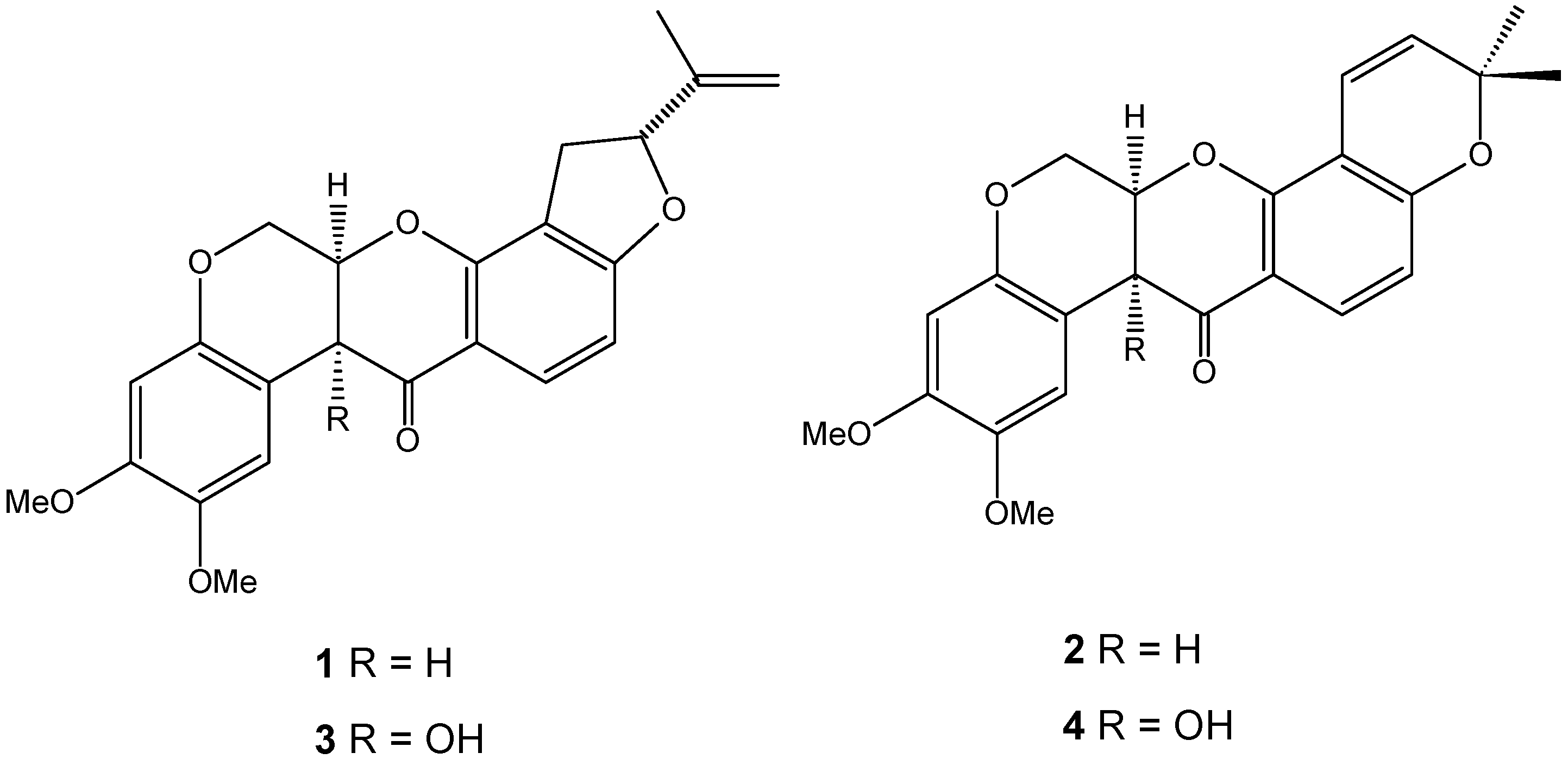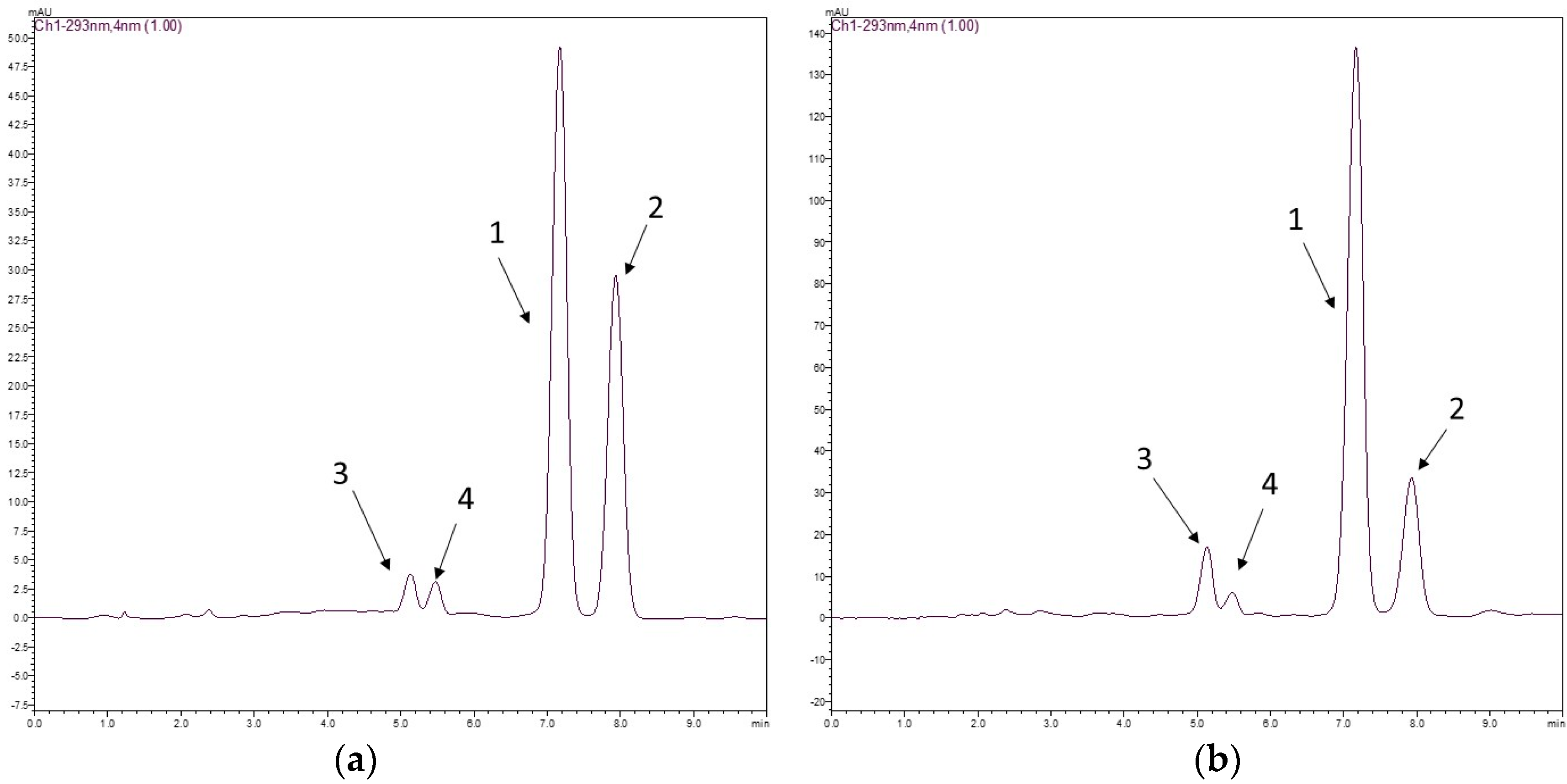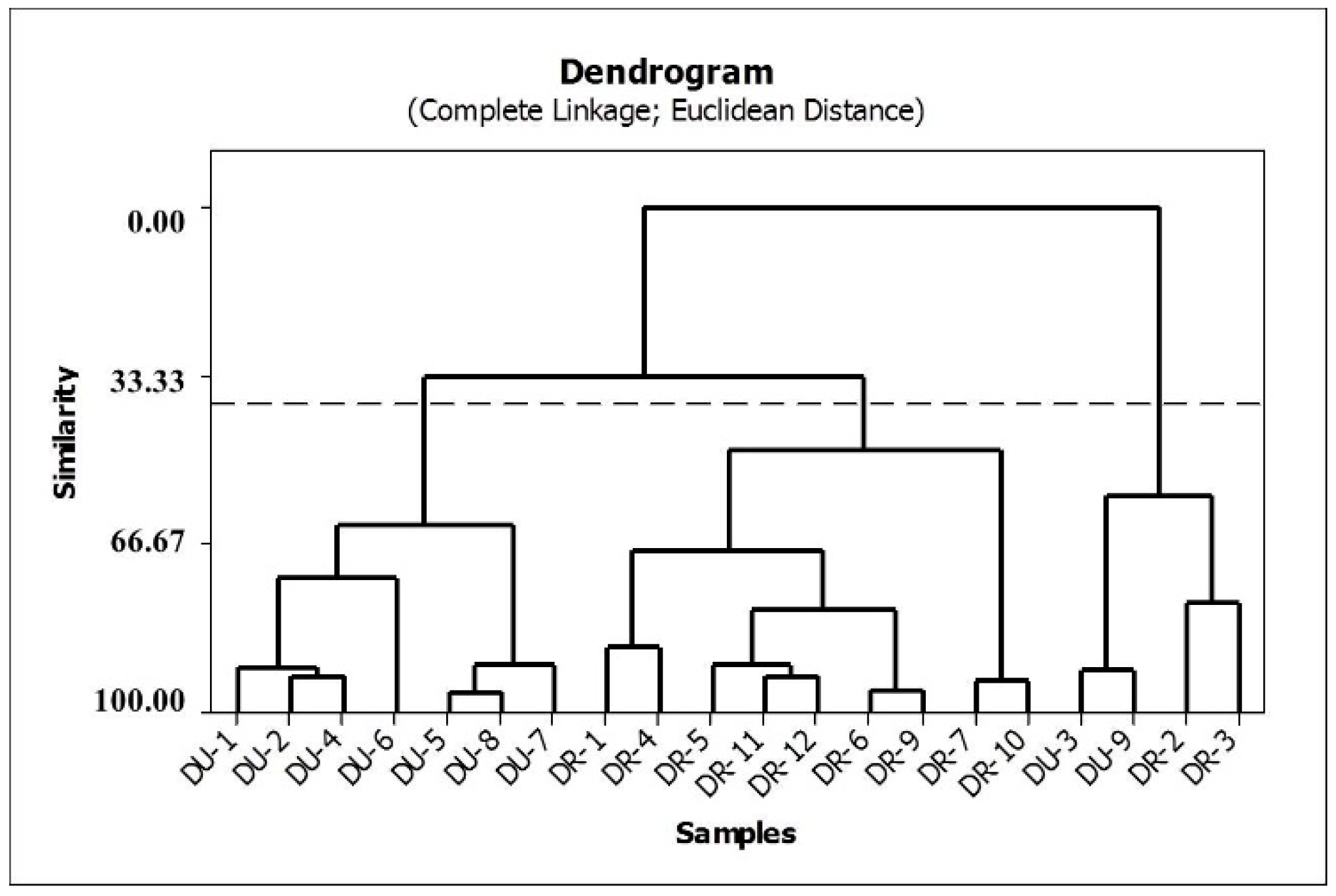Using LC and Hierarchical Cluster Analysis as Tools to Distinguish Timbó Collections into Two Deguelia Species: A Contribution to Chemotaxonomy
Abstract
:1. Introduction
2. Results
2.1. Validation of the HPLC Methodology
2.1.1. Selectivity
2.1.2. Linearity
2.1.3. Precision and Accuracy
2.2. Determination of Concentrations of Rotenone and Deguelin
2.3. Hierarchical Cluster Analysis
3. Discussion
4. Materials and Methods
4.1. General
4.2. Plant Material
4.3. Calibration Standards and Quality Control Samples
4.4. HPLC Determinations
4.5. Validation of Analytical Method
4.6. Preparation of Samples
4.7. Hierarchical Cluster Analysis (HCA)
4.8. Statistical Analysis
5. Conclusions
Acknowledgments
Author Contributions
Conflicts of Interest
Abbreviations
| HPLC | high-performance liquid chromatography |
| PDA | photodiode array |
| HCA | hierarchical cluster analysis |
| PD | Parkinson’s disease |
| UV | Ultraviolet |
| LOD | limit of detection |
| LOQ | limit of quantitation |
| QC | quality control |
| DR | Deguelia rufescens var. urucu |
| DU | Deguelia utilis |
| ND | not detected |
| RSD | relative standard deviation |
References
- Fukami, H.; Nakajima, M. Naturally Occurring Insecticides; Dekker: New York, NY, USA, 1971. [Google Scholar]
- Tozzi, A.M.G.A. The identity of timbó-verdadeiro: Deguelia utilis (A.C.Sm.) A.M.G. Azevedo (Leguminosae-Papilionoideae). Rev. Bras. Biol. 1998, 58, 511–516. [Google Scholar] [CrossRef]
- Ducke, A. Notas Sobre a Flora Neotrópica—II as leguminosas da Amazônia brasileira. Bolm. Téc. Inst. Agron. N. 1949, 18, 171–200. [Google Scholar]
- Lôbo, L.T.; da Silva, G.A.; Ferreira, M.; da Silva, M.N.; Santos, A.S.; Arruda, A.C.; Guilhon, G.M.S.P.; Santos, L.S.; Borges, R.S.; Arruda, M.S.P. Dihidroflavonols from the leaves of Derris urucu (Leguminosae): Structural elucidation and DPPH radical-scaveging activity. J. Braz. Chem. Soc. 2009, 20, 1082–1088. [Google Scholar] [CrossRef]
- De Oliveira, D.G.; de Almeida, C.M.C.; e Silva, C.Y.Y.; Arruda, M.S.P.; Lopes, D.C.F.; Yamada, E.S.; da Costa, E.T.; da Silva, M.N. Flavonoids from the leaves of Deguelia utilis (Leguminosae): Structural elucidation and neuroprotective properties. J. Braz. Chem. Soc. 2012, 23, 1933–1939. [Google Scholar] [CrossRef]
- Pereira, A.C.; Arruda, M.S.; da Silva, E.A.; da Silva, M.N.; Lemos, V.S.; Cortes, S.F. Inhibition of α-glucosidase and hypoglycemic effect of stilbenes from the Amazonian plant Deguelia rufescens var. urucu (Ducke) A.M.G. Azevedo (Leguminosae). Planta Med. 2012, 78, 36–38. [Google Scholar] [PubMed]
- Cabizza, M.; Angioni, A.; Melis, M.; Cabras, M.; Tuberoso, C.V.; Cabras, P. Rotenone and rotenoids in cube resins, formulations, and residues on olives. J. Agric. Food Chem. 2004, 52, 288–293. [Google Scholar] [CrossRef] [PubMed]
- Cabras, P.; Cabone, P.; Cabras, M.; Angioni, A.; Russo, M. Rotenone residues on olives and in olive oil. J. Agric. Food Chem. 2002, 50, 2576–2580. [Google Scholar] [CrossRef] [PubMed]
- Veitch, N.C. Isoflavonoids of the Leguminosae. Nat. Prod. Rep. 2009, 26, 776–802. [Google Scholar] [CrossRef] [PubMed]
- Sherer, T.B.; Betarbet, R.; Testa, C.M.; Seo, B.B.; Richardson, J.R.; Kim, J.H. Mechanism of toxicity in rotenone models of Parkinson’s disease. J. Neurosci. 2003, 23, 10756–10764. [Google Scholar] [PubMed]
- Hancock, D.B.; Martin, E.R.; Mayhew, G.M.; Stajich, J.M.; Jewett, R.; Stacy, M.A.; Scott, B.L.; Vance, J.M.; Scott, W.K. Pesticide exposure and risk of Parkinson’s disease: A family-based case-control study. BMC Neurol. 2008, 8, 6–17. [Google Scholar] [CrossRef] [PubMed]
- Ismann, M.B. Botanical insecticides, deterrents and repellents in modern agriculture and an increasingly regulated world. Annu. Rev. Entomol. 2006, 51, 45–66. [Google Scholar] [CrossRef] [PubMed]
- Morse, M.; Ward, A.; McNamara, N.; Denholm, I. Exploring the factors that influence the uptake of botanical insecticide by farmers: A case study of tobacco-based products in Nigeria. Exp. Agric. 2002, 38, 469–479. [Google Scholar] [CrossRef]
- Isman, M.B. Botanical insecticides: For richer, for poorer. Pest Manag. Sci. 2008, 64, 8–11. [Google Scholar] [CrossRef] [PubMed]
- Souza Filho, A.P.D.S.; do Nascimento, J.L.M. Timbó: Aspectos Botânicos e Moléculas Bioativas; Embrapa Amazônia Oriental: Belém, Brazil, 2012. [Google Scholar]
- Gobbo-Neto, L.; Lopes, N.P. Plantas medicinais: Fatores de influência no conteúdo de metabólitos secundários. Quím. Nova 2007, 30, 374–381. [Google Scholar] [CrossRef]
- Magalhães, A.F.; Tozzi, A.M.G.A.; Magalhães, E.G.; Moraes, R.S.M. Prenylated flavonoids from Deguelia hatschbachii and their systematic significance in Deguelia. Phytochemistry 2001, 57, 77–89. [Google Scholar] [CrossRef]
- Sartor, C.I.P.; da Silva, M.F.G.F.; Fernandes, J.B.; Vieira, P.C.; Fo, E.R.; Cortez, D.A.G. Alkaloids from Dictyoloma vandellianum: Their chemosystematic significance. Phytochemistry 2003, 63, 185–192. [Google Scholar] [CrossRef]
- Jiménez, J.J.; Bernal, J.L.; del Nozal, M.J.; Novo, M.; Higes, M.; Llorente, J. Determination of rotenone residues in raw honey by solid-phase extraction and high-performance liquid chromatography. J. Chromatogr. A 2000, 871, 67–73. [Google Scholar] [CrossRef]
- Caboni, P.; Sarais, G.; Angioni, A.; Garau, V.L.; Cabras, P. Fast and Versatile Multiresidue Method for the Analysis of Botanical Insecticides on Fruits and Vegetables by HPLC/DAD/MS. J. Agric. Food Chem. 2005, 53, 8644–8649. [Google Scholar] [CrossRef] [PubMed]
- Lautié, E.; Rozet, E.; Hubert, P.; Queting Leclercq, J. Quantification of rotenone in seeds of different species of yam bean (Pachyrhizus sp.) by a SPE HPLC-UV method. Food Chem. 2012, 131, 1531–1538. [Google Scholar] [CrossRef]
- Semmar, N.; Jay, M.; Nouira, S. A new approach to graphical and numerical analysis of links between plant chemotaxonomy and secondary metabolism from HPLC data smoothed by a simplex mixture design. Chemoecology 2007, 17, 139–156. [Google Scholar] [CrossRef]
- Crombie, L.; Whiting, D.A. Review article 135 biosynthesis in the rotenoid group of natural products: Applications of isotope methodology. Phytochemistry 1998, 49, 1479–1507. [Google Scholar] [CrossRef]
- Da Costa, J.P.C.; Bélo, M. Teores de rotenona em clones de timbó (Derris spp., Fabaceae) de diferentes regiões da Amazônia e os seus efeitos na emergência de imagos em Musca domestica L. Acta Amazon. 1999, 29, 563–573. [Google Scholar] [CrossRef]
- Sharaf, M.A.; Illman, D.L.; Kowalski, B.R.; Kirk-Othmer. Encyclopedia of Chemical Technology Chemometrics; Wiley: New York, NY, USA, 1986. [Google Scholar]
- Sample Availability: Not available.




| Analytes | Regression Equation | r2 | LOD 1 (μg) | LOQ 2 (μg) |
|---|---|---|---|---|
| Rotenone | y = 43442x − 3906 | 0.9998 | 0.01 | 0.10 |
| Deguelin | y = 23578x − 2709 | 0.9997 | 0.02 | 0.24 |
| Analytes | Intraday Precision (RSD%) | Interday Precision (RSD%) | Intraday Accuracy | Interday Accuracy |
|---|---|---|---|---|
| Rotenone | 0.9–12.2 | 0.9–5.0 | 93.1–113.8 | 92.5–107.1 |
| Deguelin | 0.8–5.6 | 1.8–4.8 | 90.0–107.6 | 90.0–107.3 |
| D. utilis | D. rufescens var. Urucu | ||||
|---|---|---|---|---|---|
| Sample | Rotenone | Deguelin | Sample | Rotenone | Deguelin |
| DU-1 b | 109.08 ± 1.82 | 94.47 ± 0.75 | DR-1 c | 184.44 ± 3.58 | 76.91 ± 3.40 |
| DU-2 | 122.82 ± 0.37 | 97.29 ± 0.61 | DR-2 | 117.89 ± 13.62 | 65.00 ± 8.51 |
| DU-3 | 70.99 ± 1.40 | 49.01 ± 1.13 | DR-3 | 128.42 ± 4.11 | 49.07 ± 1.82 |
| DU-4 | 123.46 ± 3.30 | 91.91 ± 3.62 | DR-4 | 164.60 ± 0.71 | 72.09 ± 1.27 |
| DU-5 | 93.14 ± 0.06 | 72.46 ± 0.43 | DR-5 | 136.83 ± 0.43 | 64.40 ± 0.13 |
| DU-6 | 77.74 ± 7.23 | 95.34 ± 5.99 | DR-6 | 147.79 ± 19.22 | 75.97 ± 10.30 |
| DU-7 | 80.88 ± 5.96 | 77.32 ± 3.32 | DR-7 | 178.12 ± 5.95 | 99.49 ± 1.61 |
| DU-8 | 89.23 ± 2.84 | 75.12 ± 0.28 | DR-8 | 278.11 ± 13.44 | 129.52 ± 3.17 |
| DU-9 | 60.55 ± 4.19 | 44.26 ± 2.61 | DR-9 | 140.02 ± 6.92 | 76.89 ± 2.56 |
| DU-10 | ND d | ND | DR-10 | 186.35 ± 1.69 | 96.49 ± 2.86 |
| - | - | DR-11 | 150.70 ± 15.95 | 67.93 ± 8.41 | |
| - | - | DR-12 | 152.87 ± 1.23 | 62.68 ± 3.90 | |
© 2016 by the authors. Licensee MDPI, Basel, Switzerland. This article is an open access article distributed under the terms and conditions of the Creative Commons Attribution (CC-BY) license ( http://creativecommons.org/licenses/by/4.0/).
Share and Cite
Da Costa, D.; E Silva, C.; Pinheiro, A.; Frommenwiler, D.; Arruda, M.; Guilhon, G.; Alves, C.; Arruda, A.; Da Silva, M. Using LC and Hierarchical Cluster Analysis as Tools to Distinguish Timbó Collections into Two Deguelia Species: A Contribution to Chemotaxonomy. Molecules 2016, 21, 569. https://doi.org/10.3390/molecules21050569
Da Costa D, E Silva C, Pinheiro A, Frommenwiler D, Arruda M, Guilhon G, Alves C, Arruda A, Da Silva M. Using LC and Hierarchical Cluster Analysis as Tools to Distinguish Timbó Collections into Two Deguelia Species: A Contribution to Chemotaxonomy. Molecules. 2016; 21(5):569. https://doi.org/10.3390/molecules21050569
Chicago/Turabian StyleDa Costa, Danielle, Consuelo E Silva, Aline Pinheiro, Débora Frommenwiler, Mara Arruda, Giselle Guilhon, Cláudio Alves, Alberto Arruda, and Milton Da Silva. 2016. "Using LC and Hierarchical Cluster Analysis as Tools to Distinguish Timbó Collections into Two Deguelia Species: A Contribution to Chemotaxonomy" Molecules 21, no. 5: 569. https://doi.org/10.3390/molecules21050569







